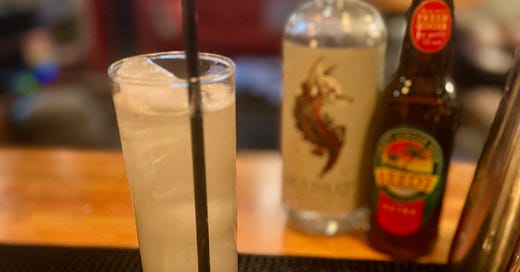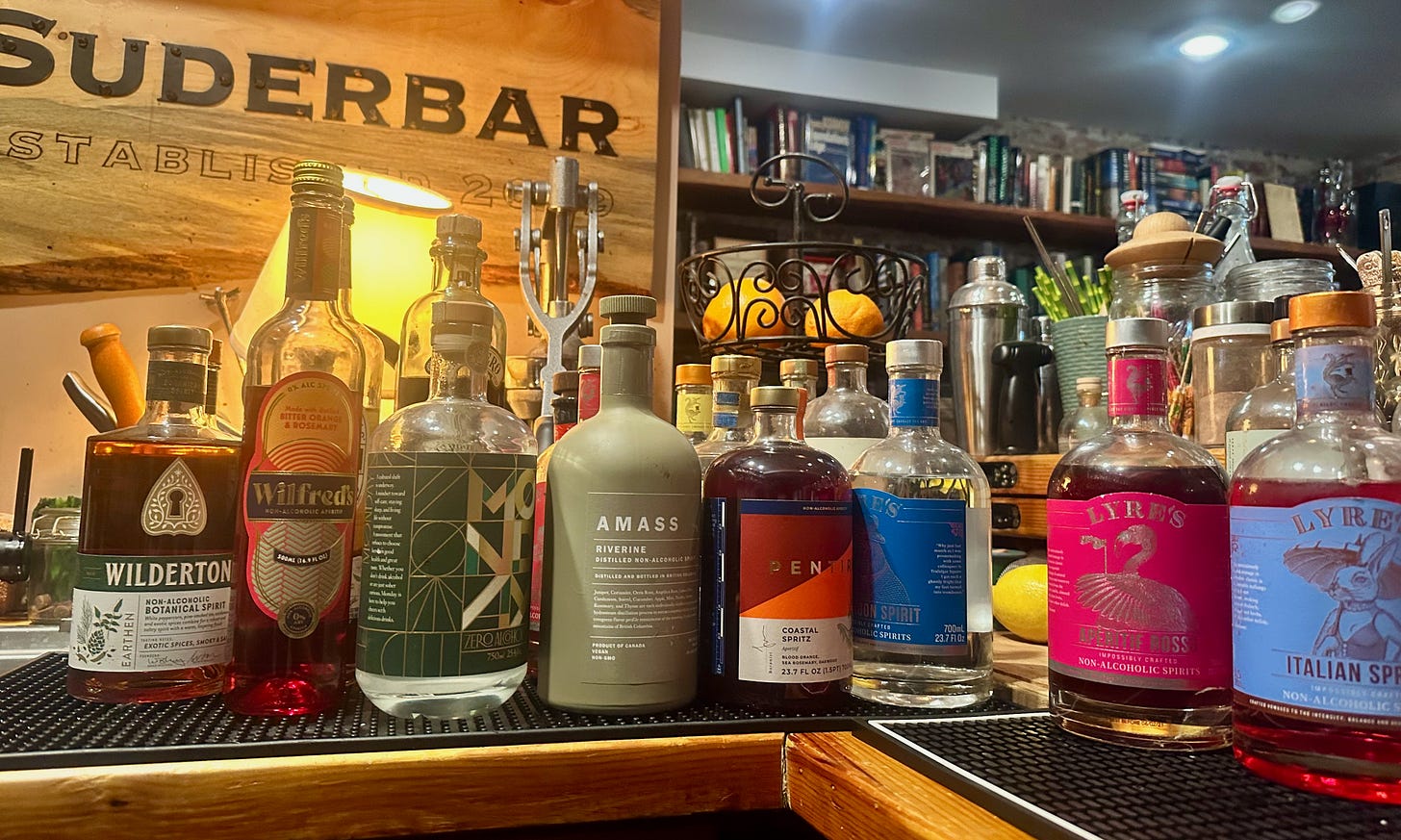How to Think About Non-Alcoholic Cocktails
Towards a general theory of NA drinks. Plus! An original NA recipe.
Some of the most common cocktail-related questions I get asked are about non-alcoholic (NA) cocktails: Are they any good? How do you make them? What bottles should a home bartender who wants to get started on NA drinks stock? How do they differ from traditional cocktails? Do we really have to call them mocktails?
For a long time, I’ve held off on trying to answer those questions in a comprehensive way—not because I didn’t know anything at all, but because I lacked a theory, a generalizable, systematic, complete approach to making and understanding the new wave of non-alcoholic cocktails.
Well, I still don’t have one. I’m not sure anyone really does. (Though if anyone might, it’s former Columbia Room mastermind Derek Brown, the man who served me my first truly great boozy cocktails, and who has recently turned his attention to NA drinks. Yes, he has a Substack!)
But I can say this for sure: You do not have to call them mocktails.
As for the rest, well, I don’t have all the answers. But I do have enough insights and ideas that I think they’re worth sharing as part of a journey toward the development of a general theory of NA drinks for home bartenders.
The thing is: Non-alcoholic cocktails are a lot like cosmology. There are many competing theories, and thanks to new inventions and new information, our understanding of the fundamentals changes all the time. What’s clear, however, is that as with the universe, the unexplored territory remains vast. The possibility space is practically infinite, and largely unknown. That’s part of what makes it so exciting. Who knows what we’ll discover?
We won’t be strictly observing Dry January for the full month in this newsletter. But as this year’s Dry January begins, I wanted to organize and summarize what I’ve learned about the NA category, and how I have come to understand it.
So I’m going to offer a number of ways to understand NA cocktails—not a complete theory, but a series of precepts, guidelines, and rules of thumb to help you think through NA drinks and how they work.
Broadly speaking, in this edition, we will…
Go over how NA cocktails are and aren’t like conventional boozy cocktails
Discuss a few basic tips and tricks for making, testing, and improving NA drinks
Look at some useful NA cocktail structures and ratios
Briefly review some of the NA spirits and brands on the market, and make some recommendations about useful bottles.
Talk about NA Negronis, because Negronis—Nogronis? NAgronis?—are forever
And then, at the end, we’ll make a zesty, aromatic, ginger-spiked original NA cocktail built from one of my favorite non-alcoholic spirits, Seedlip Spice 94.
Understanding Non-Alcoholic Cocktails
I’ve only been playing with NA cocktails for about four years now, versus about a decade with traditional cocktails. But I have a modest collection of NA bottles, and I’ve enjoyed zero-proof cocktails at places like Death & Co. in Washington, D.C., and the Baldwin Bar in Woburn, Massachusetts.
And I think the first thing to understand is this:
NA cocktails have to compete not only with boozy cocktails, but with other non-alcoholic drinks.
The fundamental challenge for most NA cocktails is that they have to improve on the many, many excellent non-alcoholic drinks that already exist in the world: coffee, specialty sodas, juice, energy drinks, tonic water, milkshakes, and so forth. The world is already awash in delicious beverages that do not contain alcohol. An NA cocktail needs to be better than those beverages in some clearly defined way.
This is not impossible. But it’s not exactly easy either.
Sometimes the use-case for an NA cocktail is just that it’s a stylish novelty drink, something prepared with care that fits a social occasion. With NA cocktails, the experience—the ineffable, subjective, aesthetic-artistic-environmental vibe beyond just the liquid in the glass—is often as or more important as the underlying drink. That’s especially true in purpose-built bar or restaurant settings. But it can be true at home as well, in situations where it’s important to make something special for someone, even if that special something doesn’t contain alcohol.
But if we’re just going to think about them as drinks, then NA cocktails specifically have to improve upon:
Ginger ale/ginger beer
Tea
So it’s no surprise that you’ll find quite a lot of NA cocktails turn out to either use those ingredients or are, essentially, just cleverly gussied up versions of tea, lemonade, or ginger ale.
That brings us to to the second point I want to make:
You aren’t going to find an NA Old Fashioned that tastes and feels like a boozy Old Fashioned.
The NA cocktail category struggles most when attempting to mimic stirred-and-boozy favorites like the Old Fashioned, the Manhattan, and the Martini. This will inevitably be a disappointment to the Vieux Carré Guys (and Gals) reading this, but no non-alcoholic cocktail fully captures the satisfying, slow-burn sippability of the classic all-booze cocktails. The Cold Weather Comfort Cocktail Canon cannot be made convincingly with non-alcoholic ingredients.
Indeed, I don’t believe I have ever had a truly great NA cocktail consisting entirely of NA spirits and nothing else. (The NA Negroni is a quasi-exception that we’ll discuss more later.)
I have not tried every single NA liquor-like product on the market, so perhaps I’ve missed something special. But I have a couple dozen bottles in my collection. And broadly speaking, the weakest and least satisfying entrants in the NA spirits are those that attempt to replicate long-aged, high-proof spirits.
That doesn’t mean the code won’t be cracked eventually. After all, NA beer has become much, much better over the past decade, thanks to intense competition and demand. NA spirits could follow the same path.
It also doesn’t mean those NA spirits can’t be used well, in quality drinks. But non-alcoholic “whiskey alternatives” just don’t come across anything like actual whiskey. They lack the body weight, the ethanol burn and palate pushback, the richness and character of real, quality, aged booze.
If that’s what you’re looking for in a drink without alcohol, then what you really want is tea.
In fact, tea is sometimes used in NA drinks in part because it has a somewhat similar strength and intensity as dark, aged spirits.
You can build a good NA drink with tea. But fundamentally, you’re just drinking tea.
And you know what? There’s nothing wrong with that. On a cold night, high-quality hot tea is excellent. Maybe add a bit of honey, perhaps and a dash of bitters. The cozy appeal of a warm mug of tea by a fire has a lot in common with the appeal of two fingers of good whiskey. But it’s tea, not whiskey.
Speaking of weather…
NA cocktails are, for the most part, summer drinks.
I understand the purpose of Dry January, which is to act as a sort of post-holiday season cleanse, a reset and rebalancing following a time of social excess.
But I’ve always thought that we should replace Dry January with Dry July, or perhaps Dry August.
Because the best NA cocktails tend to be sparkly, bright, juicy, tart, effervescent, a little bit sweet. They’re more like Daiquiris, highballs, Collins-style long drinks, and juicy tiki treats than the usual cold-weather libations.
NA versions of these drinks don’t offer one-for-one replicas of their boozy alternative—you’ll never make a true Daiquiri without rum, or a fully convincing Pisco Sour without real Pisco—but at times they can come reasonably close. They’re not twin siblings, but they are cousins, or perhaps first cousins once removed.
In NA cocktails, the mixers have to do more work.
It’s not just that NA cocktails are lighter and livelier. It’s that they tend to rely more heavily on mixing ingredients—fresh juices, complex syrups, novelty sodas and tonic water, salt and vinegar, brine and egg.




